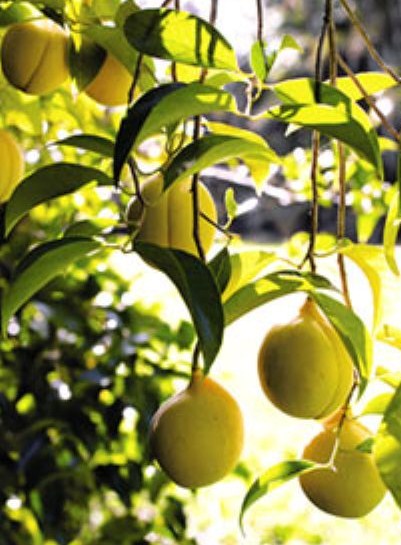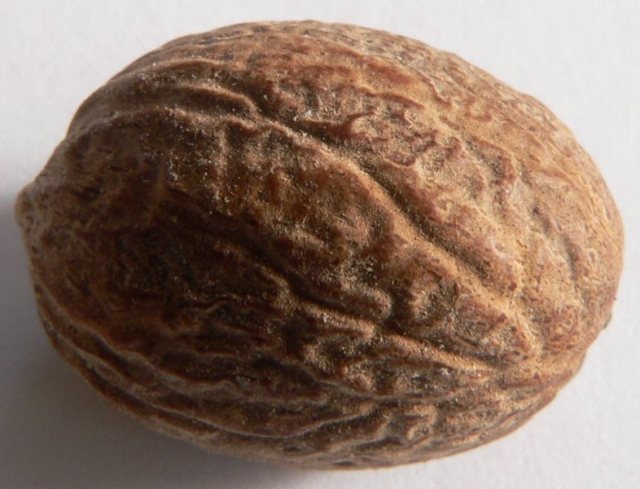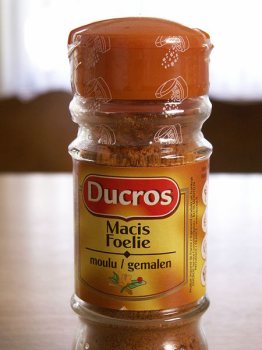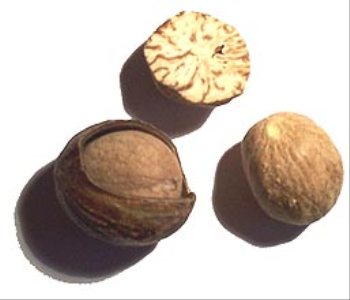Nutmeg

|
Nutmeg
Nutmeg or Myristica fragrans is an evergreen tree
indigenous to the Banda Islands in the Moluccas of Indonesia, or Spice Islands. Until the mid 19th century this was
the world's only source. The nutmeg tree is important for two spices derived from the fruit, nutmeg and mace.
Nutmeg is the actual seed of the tree, roughly
egg-shaped about an inch long, ¾ inch wide and weighing
between ¼ ounce and ½ ounce dried, while mace is the dried "lacy" reddish
covering or arillus of the seed. This is the only
tropical fruit that is the source of two different spices. Several other commercial products are
also produced from the trees, including essential oils, extracted oleoresins and nutmeg
butter. The outer surface of the nutmeg
bruises easily. The pericarp (fruit/pod) is used in Grenada to make a jam called "Morne Delice". In Indonesia, the fruit is also made into jam, called selei buah pala, or sliced finely, cooked and crystallised to make a fragrant candy called manisan pala ("nutmeg sweets").
Nutmeg
The most important species commercially is the Common or Fragrant Nutmeg Myristica fragrans, native to the Banda Islands; it is also grown on Penang Island in Malaysia and the Caribbean, especially Grenada. It also grows in Kerala, a state in the south part of India. Other species include Papuan Nutmeg Myritica argentea from New Guinea and Bombay Nutmeg Myristica malabarica from India, called Jaiphal in Hindi; both are used as adulterants of Myristica fragrans products.
A commercial jar of nutmeg mace
Culinary
uses Nutmeg and mace have similar taste
qualities, nutmeg having a slightly sweeter and mace a more delicate flavour.
Mace is often preferred in light dishes for the bright orange, saffron-like hue it imparts. Nutmeg is a
tasty addition to cheese sauces and is best grated fresh. Nutmeg is a traditional ingredient
in mulled cider, mulled wine and eggnog. In Penang cuisine nutmeg is made into pickles, shredded
as toppings on the uniquely Penang Ais Kacang. Nutmeg is also blended (creating a
fresh, green, tangy taste and white colour juice) or boiled (resulting in a much
sweeter and brown juice) to make Iced Nutmeg juice or as it is called in Penang
Hokkien, "Lau Hau Peng". In Indian cuisine nutmeg is used in many sweet as well as savoury dishes (predominantly in Mughlai cuisine). In Middle Eastern cuisine nutmeg grounds are often used as a spice for savoury dishes. In Arabic, nutmeg is called Jawzt
at-Tiyb. In Greece and Cyprus nutmeg is called μοσχοκάρυδο
(moschokarydo) (Greek: "musky nut" and is used in cooking and savoury
dishes. In European cuisine, nutmeg and mace are used especially in potato dishes and in processed meat products; they are also used in soups, sauces, and baked goods. In Dutch cuisine nutmeg is quite popular, it is added
to vegetables like Brussels sprouts, cauliflower, and string
beans. Japanese varieties of curry powder include nutmeg as an
ingredient. In the Caribbean, nutmeg is often used in drinks such as the Bushwacker, Painkiller and Barbados rum punch. Typically it is just a sprinkle on the top of the drink.
Essential
oils Penang boasts of its industry of
nutmeg oil for external medicinal use, although
the manufacturing may be sourced throughout Malaysia. The essential oil is
obtained by the steam distillation of ground nutmeg and is used heavily
in the perfumery and pharmaceutical industries. The oil is colourless or
light yellow, and smells and tastes of nutmeg. It contains numerous components
of interest to the oleochemical industry, and is used as a natural
food flavouring in baked goods, syrups, beverages, and sweets. It replaces
ground nutmeg as it leaves no particles in the food. The essential oil is also
used in the cosmetic and pharmaceutical industries, for instance, in
toothpaste and as a major
ingredient in some cough syrups. In traditional medicine nutmeg and
nutmeg oil were used for illnesses related to
the nervous and digestive systems. Nutmeg
butter Nutmeg butter is obtained from the nut
by _expression_. It is semi-solid, reddish brown in
colour, tastes and smells of nutmeg. Approximately 75% (by weight) of
nutmeg butter is trimyristin, which can be turned into myristic
acid, a 14-carbon fatty acid which can be used as a replacement
for cocoa butter, can be mixed with other fats like
cottonseed oil or palm oil, and has applications as an
industrial lubricant.
History There is some evidence to suggest that
Roman priests may have burned nutmeg as a form of
incense, although this is disputed. It is
known to have been used as a prized and costly spice in medieval
cuisine, used as flavourings, medicines,
preserving agents, that were at the time highly valued in European markets.
Saint Theodore the Studite ( 758 – 826 ) was famous
for allowing his monks to sprinkle nutmeg on their pease pudding when required to eat it. In
Elizabethan times it was believed that nutmeg could ward off the plague, thus
very popular. The small Banda Islands were the world's only source of
nutmeg and mace. Nutmeg was traded by Arabs during the Middle Ages and sold to the Venetians for exorbitant prices, but the
traders did not divulge the exact location of their source in the profitable
Indian Ocean trade and no European was able to deduce
their location. In August 1511, on behalf of the king of
Portugal, Afonso de Albuquerque conquered Malacca, which at the time was the hub of
Asian trade. In November of that year, after having secured Malacca and learning
of the Bandas' location, Albuquerque sent an expedition of three ships led by
his good friend Antonio de Abreu to find them. Malay pilots, either recruited or forcibly
conscripted, guided them via Java, the Lesser Sundas and Ambon to Banda, arriving in early 1512. The
first Europeans to reach the Islands, the expedition remained in Banda for about
one month, purchasing and filling their ships with nutmeg and mace, also
with cloves, a
thriving trade. The
first written accounts of Banda are in Suma Oriental, a book written by the
Portuguese apothecary Tome Pires based in Malacca from 1512 to 1515.
But full control of this trade was not possible and they remained largely
participants, rather than overlords since the authority Ternate held over the
nutmeg-growing centre of the Banda Islands was quite limited. Therefore, the
Portuguese failed to gain a foothold in the islands
themselves. The trade in nutmeg later became
dominated by the Dutch in the 17th century. The British and
Dutch engaged in prolonged struggles to gain control of Run Island, then the only source of nutmeg. At
the end of the Second Anglo-Dutch War the Dutch gained control of Run in
exchange for the British controlling New Amsterdam (New York) in North
America. The Dutch managed to establish control
over the Banda Islands after an extended military campaign
that culminated in the massacre or expulsion of most of the islands' inhabitants
in 1621. Thereafter, the Banda Islands were run as a series of plantation
estates, with the Dutch mounting annual expeditions in local war-vessels to
extirpate nutmeg trees planted elsewhere. As a result of the Dutch interregnum
during the Napoleonic Wars, the English took temporary control
of the Banda Islands from the Dutch and transplanted nutmeg trees to their own
colonial holdings elsewhere, notably Zanzibar and Grenada. Today, a stylised split-open nutmeg
fruit is found on the national flag of Grenada. Connecticut gets its nickname ("the Nutmeg State", "Nutmegger") from the legend that some unscrupulous Connecticut traders would whittle "nutmeg" out of wood, creating a "wooden nutmeg" (a term which came to mean any fraud).
The flag of Grenada with the nutmeg featured World production World production of nutmeg is
estimated to average between 10,000 and 12,000 tonnes per year with annual world demand
estimated at 9,000 tonnes; production of mace is estimated at 1,500 to 2,000
tonnes. Indonesia and Grenada dominate production and exports of
both products with a world market share of 75% and 20% respectively. Other
producers include India, Malaysia (especially Penang where the trees are native within
untamed areas), Papua New Guinea, Sri Lanka, and Caribbean islands such as St.
Vincent. The principal import markets are the
European Community, the US, Japan and India. Singapore and the Netherlands are major
re-exporters. At one time, nutmeg was one of the
most valuable spices. It has been said that several hundred years ago in England,
a few nutmeg nuts could be sold for enough money to enable financial
independence for life.
The first harvest of nutmeg trees takes place 7–9 years after planting and the trees reach their full potential after 20 years.
Psycho
activity and toxicity In low doses, nutmeg produces no
noticeable physiological or neurological response. Large doses can be dangerous
(potentially inducing convulsions, palpitations, nausea, eventual
dehydration and
generalised body pain. In large amounts it is reputed to be a strong
deleriant. Users report both negative and
positive experiences, involving strong open-eye hallucinations, and in some
cases quite severe anxiety. Users may feel a sensation of blood rush to the
head, or a strong euphoria and dissociation. Nutmeg contains
myristicin, a weak
monoamine oxidase inhibitor. Speculative comparisons between the effects of nutmeg intoxication and MDMA have been made. However, nutmeg contains no amphetamine derivatives nor are any formed in the body from the main chemical components of nutmeg. Use of nutmeg as a recreational drug is unpopular due to its unpleasant taste and its possible negative side effects, including dizziness, flushes, dry mouth, accelerated heartbeat, temporary constipation, difficulty in urination, nausea, and panic. In addition, experiences usually last well over 24 hours making recreational use rather impractical. A risk in any large-quantity ingestion of nutmeg is the onset of 'nutmeg poisoning', an acute psychiatric disorder marked by thought disorder, a sense of impending doom/death, and agitation.
ALL IN ALL A SURPRISE FIND TO US IN GRENADA |






